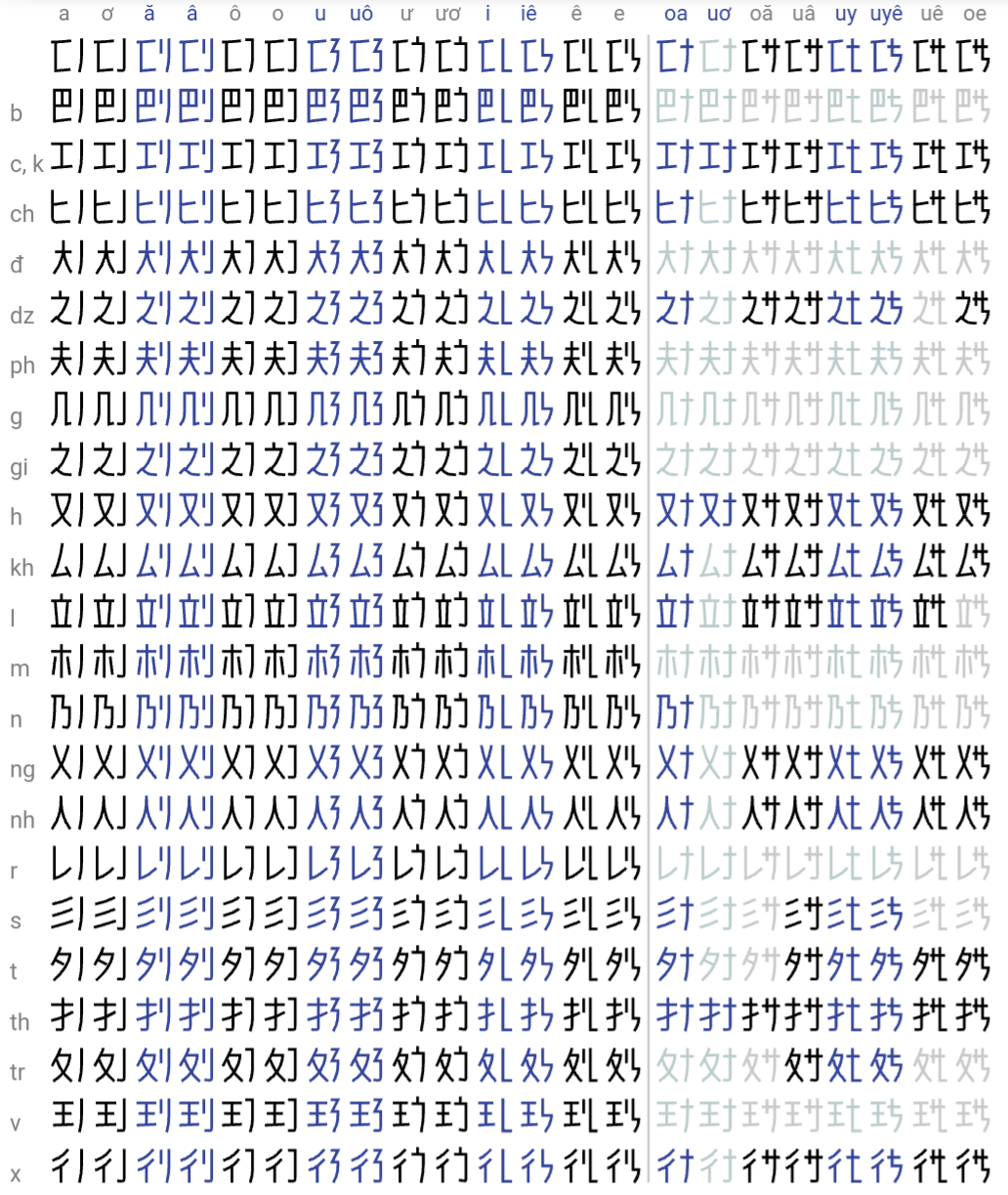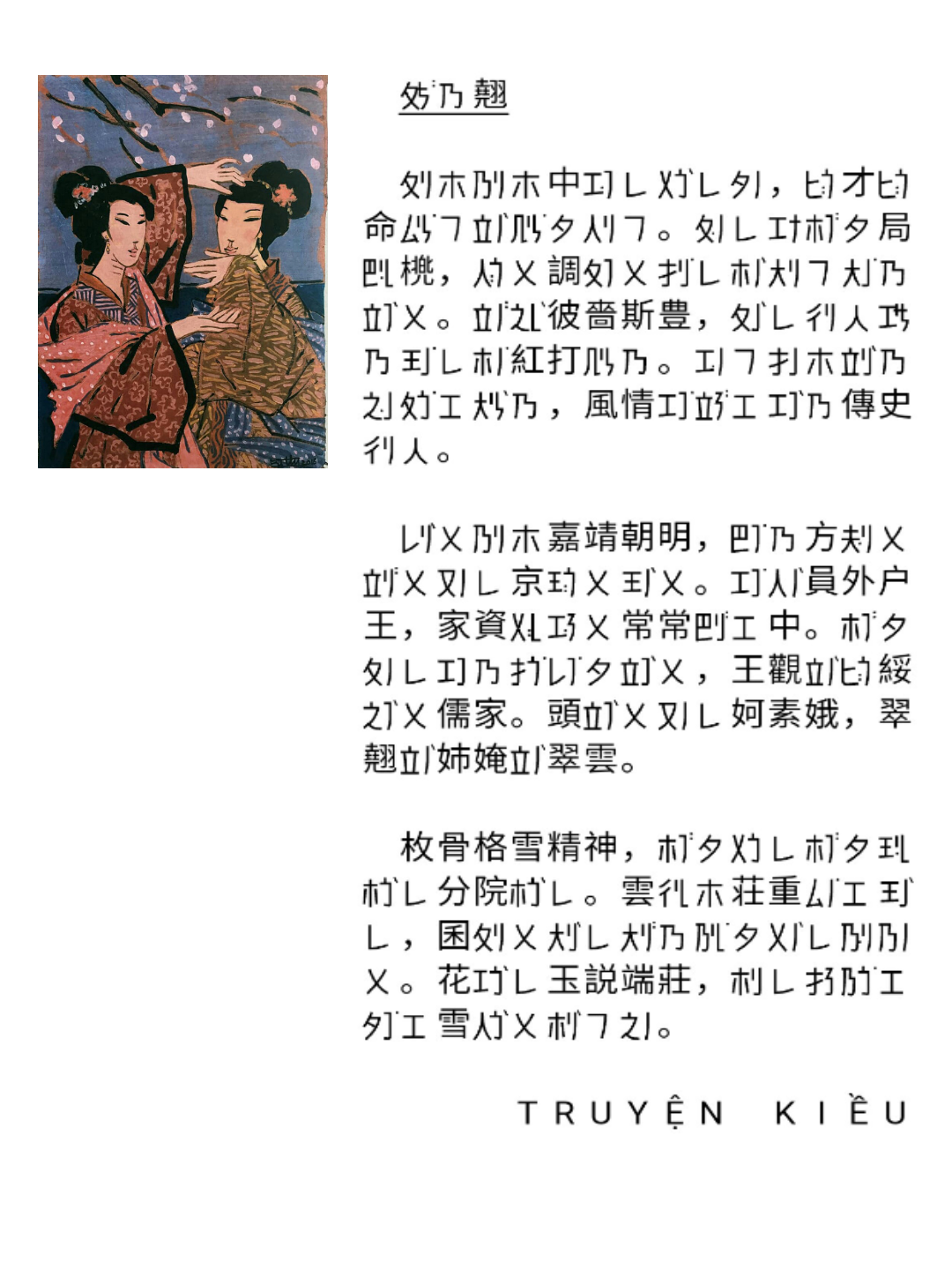Phonetic Annotation
Phonetic annotation is used on this website to offer an alternative description of pronunciations besides Quốc ngữ.
Try typing it here
A brief explanation
A syllable is split into four components: initial, nucleus, coda, tone. For example thuyền is split into: TH, UYÊ, N, and the huyền tone. For each component you can lookup the corresponding shape in the table below.
Character chart
Ignoring tones for the moment we can choose words without a coda directly from the chart. For example for ca go to the c,krow and chose the character shown in the a column, which is 工|. Similarly ta is found in the same column of the t row: 夕|.

Codas
Words that have a coda are written by extending a character from the chart with a coda symbol. For example the word caois written with the character 工| ca extended with the symbol ㇕ for the o coda, which results in 工| ㇕ cao.
Possible coda symbols are:
㇗ -i, -y
㇕ -o, -u
乃 -n
木 -m
巴 -p
工 -c
夕 -t
乂 -ng
匕 -ch
人 -nh
Alternatively a set of numeric characters that are distinct from the syllable initials can be used for certain codas: 千三十六八〇 (n m p c t ng)
Tone marks
Tones are indicated by adding diacritic marks to the vowel component of a character. The following marks can be used. One/two dots to the right side of the vowel indicate sắc/nặng. A short right slanted stroke in the same position indicates huyền. One/two dots to the left side of the vowel indicate hỏi/ngã. The neutral tone is left unmarked.
For example the word cá is written
On words ending in a stop (i.e. -c, -p, -t, -ch) the sắc tone is optional and can be left unmarked. For example the word tác夕|˙工 can be written 夕| 工 without the tone marking dot.
Alternatively to the above tone marking system, Quốc ngữ tone marks can be used. In that case the nặng tone (dot below) should be replaced by a circle symbol.
Truyện Kiều with all words written phonetically except for Chữ hán.

Author: Trung Nguyen
See more at: https://www.chunom.org/pages/pa/
Phonetic annotation is used on this website to offer an alternative description of pronunciations besides Quốc ngữ.
Try typing it here
A brief explanation
A syllable is split into four components: initial, nucleus, coda, tone. For example thuyền is split into: TH, UYÊ, N, and the huyền tone. For each component you can lookup the corresponding shape in the table below.
Character chart
Ignoring tones for the moment we can choose words without a coda directly from the chart. For example for ca go to the c,krow and chose the character shown in the a column, which is 工|. Similarly ta is found in the same column of the t row: 夕|.

Codas
Words that have a coda are written by extending a character from the chart with a coda symbol. For example the word caois written with the character 工| ca extended with the symbol ㇕ for the o coda, which results in 工| ㇕ cao.
Possible coda symbols are:
㇗ -i, -y
㇕ -o, -u
乃 -n
木 -m
巴 -p
工 -c
夕 -t
乂 -ng
匕 -ch
人 -nh
Alternatively a set of numeric characters that are distinct from the syllable initials can be used for certain codas: 千三十六八〇 (n m p c t ng)
Tone marks
Tones are indicated by adding diacritic marks to the vowel component of a character. The following marks can be used. One/two dots to the right side of the vowel indicate sắc/nặng. A short right slanted stroke in the same position indicates huyền. One/two dots to the left side of the vowel indicate hỏi/ngã. The neutral tone is left unmarked.
For example the word cá is written
- Code:
工|˙, similarly cà 工|`, cả 工·|, cã 工:|, cạ 工|:
On words ending in a stop (i.e. -c, -p, -t, -ch) the sắc tone is optional and can be left unmarked. For example the word tác夕|˙工 can be written 夕| 工 without the tone marking dot.
Alternatively to the above tone marking system, Quốc ngữ tone marks can be used. In that case the nặng tone (dot below) should be replaced by a circle symbol.
Examples
Truyện Kiều with all words written phonetically except for Chữ hán.

Author: Trung Nguyen
See more at: https://www.chunom.org/pages/pa/



 Ngày khởi sự
Ngày khởi sự Đến từ
Đến từ Côngviệc / Sởthix
Côngviệc / Sởthix

